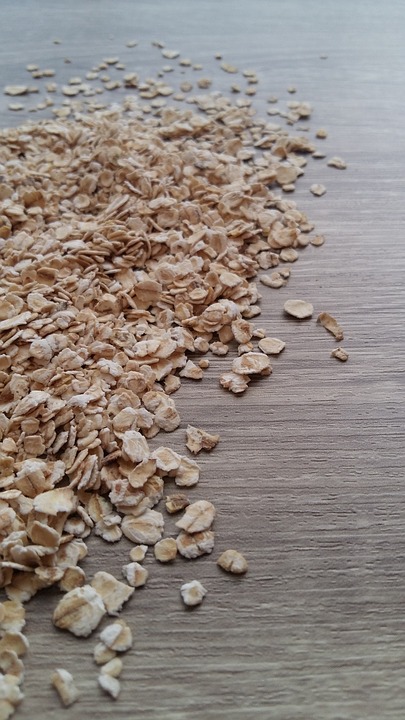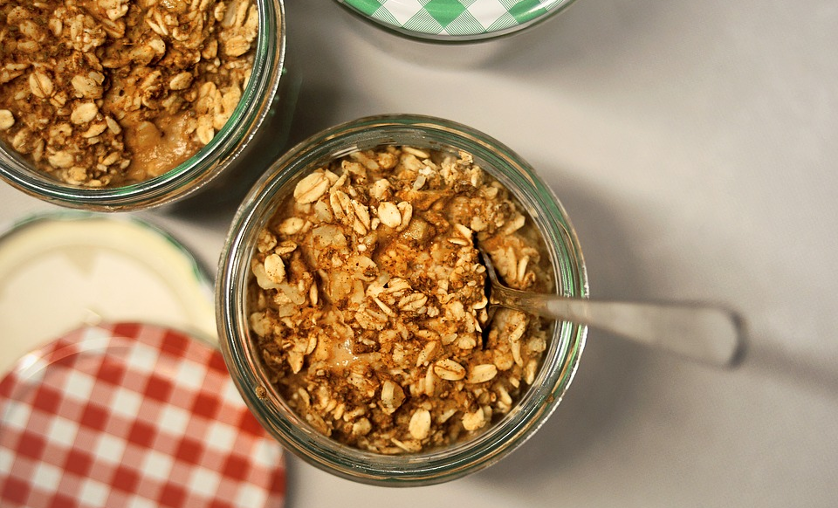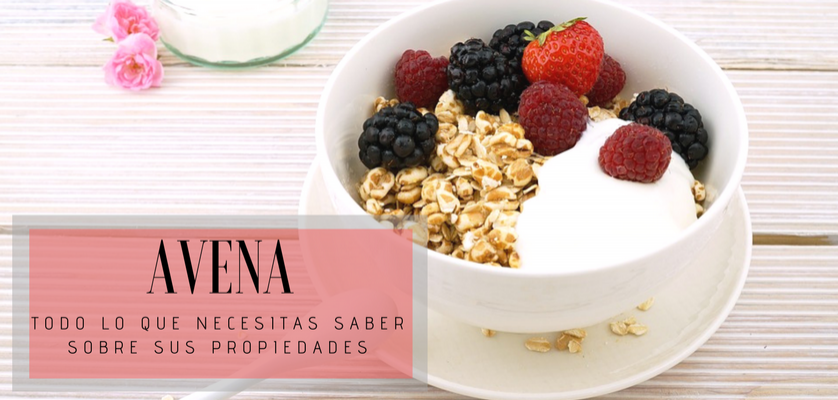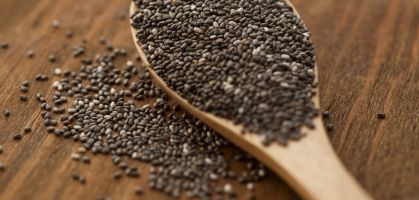Oatmeal has become in recent years one of the cereals that brings more benefits to our body bothnutritionally and energetically. From Runnea we have compiled everything you need to know, its properties, its healthy effects, and also how to cook this cereal. A regular consumption of oats could prevent some diseases and reduce risk factors for chronic diseases. Learn how to add oats to your diet!
What do oats provide us with?
Oats (Avena Sativa L.) belong to the Poaceae family and are a whole grain cereal that comes from Europe, where wild oats can still be found. Its cultivation requires a humid and cool climate. In the past, oats were only used to feed livestock, but nowadays its consumption has been spreading thanks to the knowledge that it has a high nutritionalvalor and that it has health benefits for human beings.
What are the properties of oats?

Oats have interesting nutritional properties, in addition to containing non-nutritive/bioactive components that give it added health valor. It is a very nutritious cereal with an energy valor of 361 kcal per 100g.
Oats, like all monocot cereals, contain relatively high levels of soluble fiber compared to other cereals; they also contain a third more protein, almost four times more fat and less starch.
What is the protein content of oats?
It is a source of protein (about 11-12%) containing all 8 essential amino acids. It provides carbohydrates (56%) and healthy lipids7).
Compared to other cereals, its carbohydrate content, which is basically starch, is lower and its contribution of lipids, healthy fatty acids, mostly monounsaturated and polyunsaturated, is higher.
It has a high content of iron, magnesium, zinc, phosphorus, vitamin B1 (thiamine), vitamin B6 and folates, besides being a source of potassium, vitamin K and vitamin E. It lacks vitamins B12, D, A and C.
The high zinc content facilitates the use of insulin, contributes to maturity in development and helps in the growth process, besides being beneficial for the immune system and wound healing and protein metabolization; it also helps fight fatigue and intervenes in the transport of vitamin A to the retina.
Due to its high content of vitamin B1, the consumption of oats helps to overcome stress and depression. It is highly recommended to take it in periods of pregnancy or lactation and also after operations or during periods of convalescence, because in these periods there is a greater wear of this vitamin.
The abundance of vitamin B6 makes oats highly recommended in cases of diabetes, depression and asthma. It also boosts immunity, helps prevent heart disease and cancer and can reduce carpal tunnel symptoms.
The vitamin K content makes oats beneficial for proper blood clotting and calcium metabolism.
Oats stand out for their high fiber content (between 9, soluble and insoluble), especially beta-glucans. Fiber improves intestinal transit, lowers cholesterol and glucose levels in the blood and delays gastric emptying, producing greater satiety and a feeling of fullness. Beta-glucans are polysaccharides that are components of dietary fiber, resistant to absorption and digestion in the small intestine and ferment in the colon, attenuating serum cholesterol and blood glucose response. A daily intake of 3g of beta-glucans from oats can lower total serum cholesterol as well as LDL cholesterol and blood pressure. Also, it may have an anticarcinogenic effect by reducing compounds that are causative agents of colon cancer.
Oats can lower total serum cholesterol as well as LDL cholesterol and blood pressure. Also, it may have an anticarcinogenic effect by reducing compounds that are causative agents of colon cancer.
Oats contain non-nutritive bioactive components: flavonoids, flavonolignans, phytosterols and tochols, phenolic acids, and two types of unique phytochemicals: avenanthramides (AVNs) and steroidal saponins. These, together with some micronutrients, favor different metabolic processes essential for the organism. AVNs are soluble phenolic compounds unique to oats, of low molecular weight, which are not present in other cereal grains. These compounds are produced by the plant in response to exposure to pathogens such as fungi.
These AVNs constitute the major phenolic antioxidants present in oat grain. They are produced in relatively high concentrations in the whole grain and in the outer regions of the oat kernel. In addition, they have strong antioxidant activity, anti-inflammatory, anti-proliferative, anti-atherogenic and anti-itching properties. They help control blood pressure by producing nitric oxide (vasodilator), improve endothelial function, cell signaling and have properties that may provide additional protection against coronary heart disease, colon cancer, arthritis, atherosclerosis or cataracts and skin irritation, among others.
These are the benefits of oats
Current evidence indicates that the regular incorporation of foods containing oats in the daily diet can reduce the risk of several diseases associated with inflammation.
Oats, due to their nutritional composition and presence of non-nutritive/bioactive compounds, are nutritionally beneficial and could also prevent some diseases and reduce risk factors for chronic diseases such as diabetes, obesity and metabolic syndrome, cardiovascular diseases, cancer and be useful in the treatment of intestinal diseases and celiac disease. These benefits are always associated to a regular consumption of oats and not to its sporadic intake.
It has different pharmacological activities such as: anti-inflammatory, wound healing, antioxidant, immunomodulatory, antidiabetic, anticholesterolemic, anti-itching, cytoprotective, etc. Traditionally, oats are considered as stimulant, antispasmodic, antitumor, diuretic and neurotonic.

1. Diabetes
The beta-glucans in oats may help control blood glucose. It lowers fasting glucose level, postprandial glucose, moderates insulin peaks, improves insulin resistance, reduces glycosylated hemoglobin concentration and lowers total cholesterol and LDL cholesterol.
2. Obesity and metabolic syndrome
In overweight and obese people suffering from metabolic syndrome, the fiber in oats could help in improving glucose tolerance as well as insulin sensitivity. Regular consumption of oats may help to slightly decrease body weight and BMI and limit weight gain over time.
Dietary fiber in general increases the production of short-chain fatty acids (SCFA) in the gut, which is associated with higher concentrations of appetite-suppressing hormones, such as GLP and PYY, in the postprandial phase.
3. Cardiovascular diseases
Oat consumption is associated with lower blood cholesterol and triglycerides, which may prevent the development of cardiovascular and coronary heart disease.
Soluble fiber helps decrease low-density lipoproteins (LDL) and slightly increase high-density lipoproteins (HDL). Fiber increases the viscosity of gastric contents, decreasing cholesterol absorption; it binds to bile salts increasing their excretion and stimulates the liver to use available cholesterol; beta-glucans increase the production of short-chain fatty acids, especially propionate, decreasing blood cholesterol levels.
Avenanthramides (AVNs) help to reduce coronary heart disease, as they have anti-inflammatory and antiproliferative properties that cause vasodilation. AVNs are known to play an important role in artery inflammation and the development of atherosclerosis, as they inhibit the expression of vascular endothelial adhesion cells and reduce the production of several inflammatory cytokines and chemokines involved in the formation of fatty streaks in arteries. In addition, oats improve endothelial function when consumed with vitamin C and E supplements.
AVNs reduce blood pressure by increasing the production of nitric oxide (NO) in the endothelium of the vessel wall, which mediates the relaxation of smooth muscle cells in the vascular wall, causing vasodilation and decreasing the risk of coronary heart disease.
4. Cancer
Lifestyle and diet play an important role in the etiology and prevention of different types of cancer.
AVNs have an antiproliferative effect on vascular smooth muscle cells and on several cancer cell lines, being more effective in colon cancer than in prostate or breast cancer. Oat consumption, with its high fiber and AVNs content, may reduce the risk of colon cancer.
It is believed that short-chain fatty acids (SCFAs), such as butyric, acetic and propionic acids, derived from oat dietary fiber may have potent anti-cancer activity. They are utilized by the colon mucosa as an energy source and stimulate cell proliferation in the normal colon epithelium, and may delay the growth of cancer cell lines and even induce apoptosis (cell death) in cancer cells. The level of scientific evidence is still insufficient to draw conclusions. More studies are needed to confirm this.
5. Celiac disease
Celiac disease is a systemic autoimmune disorder that is triggered by the consumption of gluten and prolamins.
Oats, as well as rice, corn, buckwheat, quinoa, millet, amaranth, sorghum and teff, do not contain gluten, but unlike these it is very difficult to be libre of gluten cross-contamination.
Consumption of libre oats can improve the nutritional quality of the diet of people with celiac disease.
6. Diseases of the gastrointestinal tract
Gastrointestinal disease is a group of pathologies affecting the small intestine, colon and rectum, including: irritable bowel syndrome (IBS), colorectal cancer and inflammatory diseases (ulcerative colitis and Crohn's disease).
The consumption of oats would be considered safe and even beneficial in patients with intestinal diseases, and may reduce some of their symptoms. It also has cytoprotective effects (protection of the mucosa of the gastrointestinal tract and cells against oxidative stress).
A higher intake of dietary fiber and whole grains is associated with a lower incidence of colorectal cancer and an increase in SCFA, recommended in inflammatory diseases. The use of oat fiber-based probiotics may result in less bloating, less flatulence and less abdominal pain.
Oat consumption prevents and improves constipation due to its fiber content.
7. Irritated skin
AVNs have an anti-itching effect and can have a soothing effect on irritated skin. It has been recognized as a remedy for the treatment of poison ivy, sunburn, eczema and psoriasis. Colloidal oat extract containing AVNs has also been shown to have antihistamine and anti-irritant activity.
8. Athletes
Because of its energy, protein, carbohydrate, vitamins and minerals content, it is an ideal food for athletes.
Oatmeal recipes: How to cook oatmeal
Depending on the presentation and preparation of oatmeal, its properties and nutritional characteristics may vary. The processing of this cereal causes changes in physical characteristics, such as glycemic index (GI) and glycemic response.
The GI is a measure of how quickly a food can raise blood glucose levels. The less processed, the less impact on blood glucose. Thus instant oatmeal has a high GI, rolled oats have a low GI, and hulled whole grain, muesli and granola have a medium GI.
The Glycemic Load (GL) is the rate at which blood glucose arrives together with the amount of carbohydrates contained in a serving of the food.
The glycemic response depends, in addition to the GI, on the carbohydrate content of the food. The lower the glycemic load of a food, the lower the blood glucose spike. For example, the blood glucose spike of a 250-gram serving of cooked oatmeal, being its average GL, is moderate. In addition, thanks to its fiber content, it increases the feeling of satiety, helping to control appetite.
It can be part of breakfast, mid-morning, lunch, snack or dinner. Oatmeal offers different possibilities of preparation: cooked, baked, raw, smoothies, dough, pancakes, etc. It is also used in soups and creams and is present as an ingredient in various dishes together with vegetables or eggs or in other preparations such as hamburgers. We also have oat-based products such as: instant oatmeal, muesli, granola or cereal bars, oat flour, breads, breakfast cereals, oat flakes, pastries and cakes, oat drink, oat-based probiotic drinks or baby food. It can be taken in the form of a food supplement.
Oats have good potential for development as a functional food. It is possible to selectively breed lines with high contents of dietary fiber and specific groups of phytochemicals.
Bibliographical references
Information from the tables on properties: http://www.dietas.net/tablas-y-calculadoras/tabla-de-composicion-nutricional-de-los-alimentos/cereales/granos-y-harinas/avena.html
General information about oats. [Accessed: 31-03-2018] Online, available at: https://alimentos.org.es/avena
HUANG Xiang-guo, GE Ju-mei. Nutrition and Function in Health Protection of Oats (Avena sativa L.). ?Acta Tritical Crops? 2004-04. http://en.cnki.com.cn/Article_en/CJFDTOTAL-MLZW200404036.htm.
Rajinder Singh, Subrata De & Asma Belkheir (2011) Avena sativa (Oat), A Potential Neutraceutical and Therapeutic Agent: An Overview, Critical Reviews in Food Science and Nutrition, 532, 126-144, DOI: 10.1080/10408398.2010.526725.
Radomir Lásztity (2009) Oat grains wonderful reservoir of natural nutrients and biologically active substances, Food Reviews International, 14:1, 99-119, DOI: 10.1080/87559129809541150
Mohsen Meydani. Potential health benefits of avenanthramides of oats. Nutrition Reviews, Volume 67, Issue 12, 1 December 2009, Pages 731-735, https://doi.org/10.1111/j.1753-4887.2009.00256.x
Peter R. Shewry, Vieno Piironen, Anna-Maija Lampi, Laura Nyström, Li Li, Mariann Rakszegi, Anna Fra?, Danuta Boros, Kurt Gebruers, Christophe M. Courtin, Jan A. Delcour, Annica A. M. Andersson, Lena Dimberg, Zoltan Bed?, and Jane L. Ward. Phytochemical and Fiber Components in Oat Varieties in the HEALTHGRAIN Diversity Screen. Journal of Agricultural and Food Chemistry 2008 56 (21), 9777-9784. DOI: 10.1021/jf801880d.
L.RyanP.S.ThondreC.J.K.Henry. Oat-based breakfast cereals are a rich source of polyphenols and high in antioxidant potential. Journal of Food Composition and Analysis. Volume 24, Issue 7, November 2011, Pages 929-934. https://doi.org/10.1016/j.jfca.2011.02.002
Pham Van Hung (2014) Phenolic Compounds of Cereals and Their Antioxidant Capacity, Critical Reviews in Food Science and Nutrition, 56:1, 25-35, DOI: 10.1080/10408398.2012.708909.
Read more news about: Nutrition











